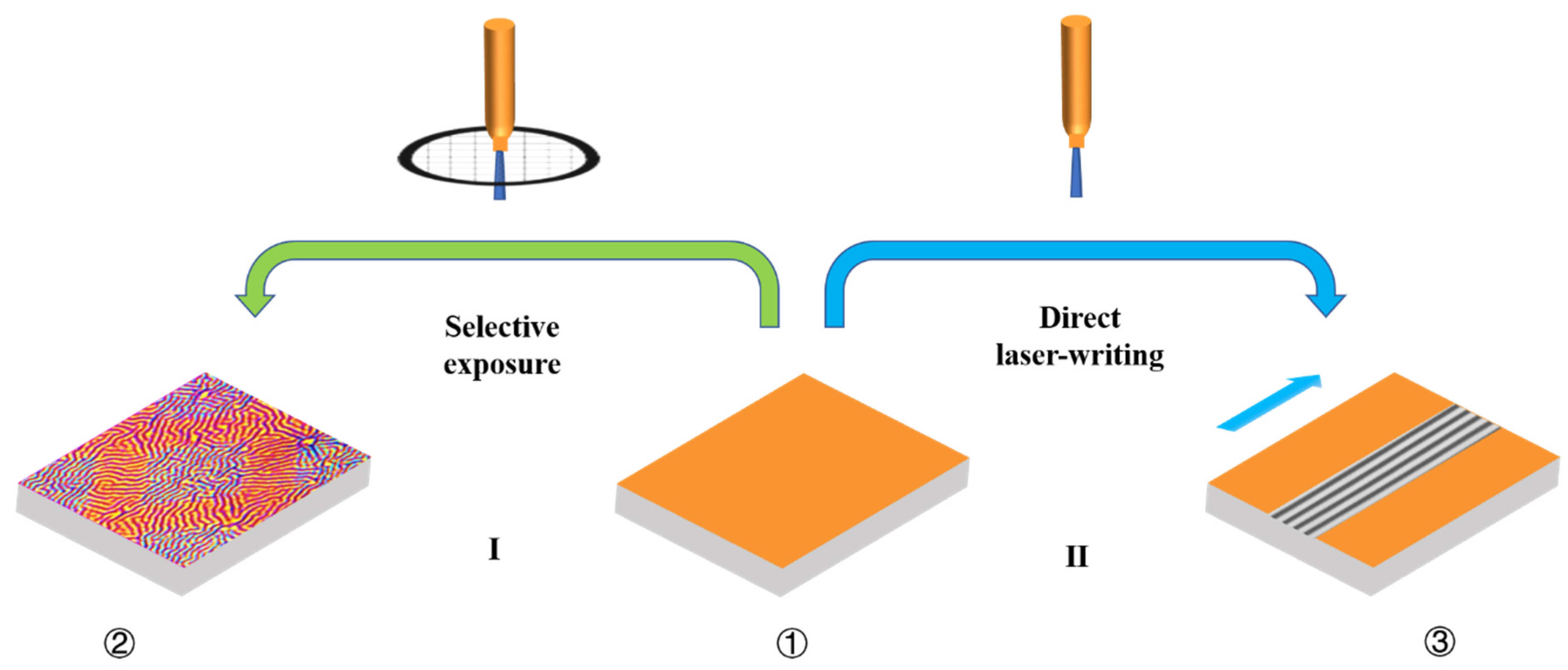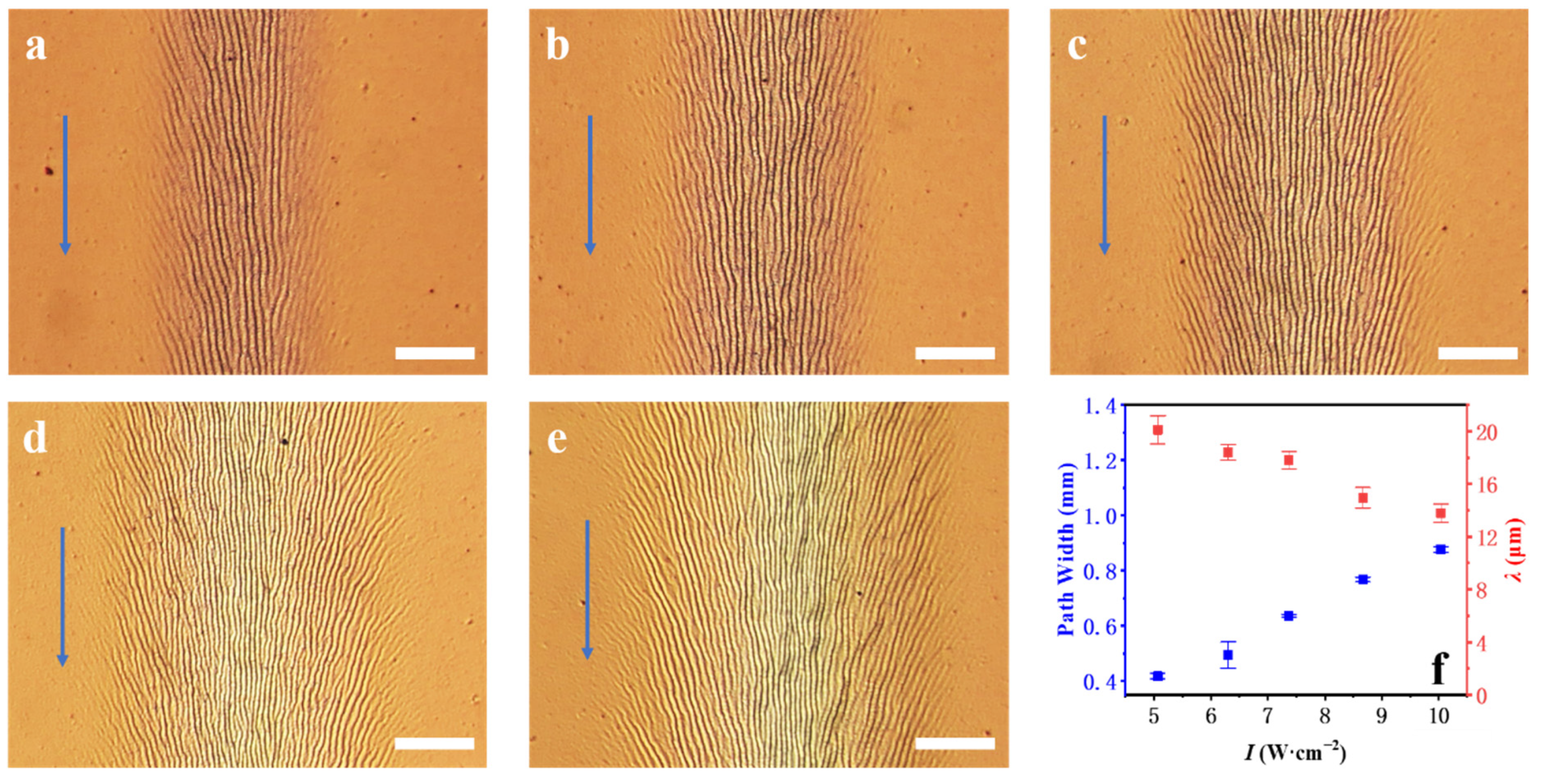Light-Induced Surface Wrinkling on Azo-Based Composite Films
Abstract
:1. Introduction
2. Materials and Methods
2.1. Fabricatin of PDMS Elastic Substrate
2.2. Synthesis of Poly (Disperse Orange 3)
2.3. The Fabrication of the (PDO3-PS)/PDMS Film/Substrate System
2.4. Surface Wrinkling of the (PDO3-PS)/PDMS Bilayer Induced by Static Selected Exposure to Laser Light
2.5. Surface Wrinkling of the (PDO3-PS)/PDMS Bilayer Induced by Direct Laser Writing
2.6. Characterization
3. Results and Discussion
3.1. Static Selective Exposure
3.2. Dynamic Moving Exposure
4. Conclusions
Supplementary Materials
Author Contributions
Funding
Institutional Review Board Statement
Informed Consent Statement
Data Availability Statement
Conflicts of Interest
References
- Zong, C.; Zhao, Y.; Ji, H.; Han, X.; Xie, J.; Wang, J.; Cao, Y.; Jiang, S.; Lu, C. Tuning and erasing surface wrinkles by reversible visible-light-induced photoisomerization. Angew. Chem. Int. Ed. 2016, 55, 3931–3935. [Google Scholar] [CrossRef] [PubMed]
- Yang, X.; Zhao, Y.; Xie, J.; Han, X.; Wang, J.; Zong, C.; Ji, H.; Zhao, J.; Jiang, S.; Cao, Y.; et al. Bioinspired fabrication of free-standing conducting films with hierarchical surface wrinkling patterns. ACS Nano 2016, 10, 3801–3808. [Google Scholar] [CrossRef] [PubMed]
- Du, Q.; Guan, Y.; Zhu, X.X.; Zhang, Y. Swelling-induced surface instability patterns guided by pre-introduced structures. Soft Matter 2015, 11, 1937–1944. [Google Scholar] [CrossRef] [PubMed]
- Hou, H.; Yin, J.; Jiang, X. Smart patterned surface with dynamic wrinkles. Acc. Chem. Res. 2019, 52, 1025–1035. [Google Scholar] [CrossRef]
- Jung, W.-B.; Cho, K.M.; Lee, W.-K.; Odom, T.W.; Jung, H.-T. Universal method for creating hierarchical wrinkles on thin-film surfaces. ACS Appl. Mater. Interfaces 2018, 10, 1347–1355. [Google Scholar] [CrossRef]
- Lee, W.-K.; Odom, T.W. Designing hierarchical nanostructures from conformable and deformable thin materials. ACS Nano 2019, 13, 6170–6177. [Google Scholar] [CrossRef]
- Lee, W.-K.; Engel, C.J.; Huntington, M.D.; Hu, J.; Odom, T.W. Controlled three-dimensional hierarchical structuring by memory-based, sequential wrinkling. Nano Lett. 2015, 15, 5624–5629. [Google Scholar] [CrossRef]
- Yang, S.; Khare, K.; Lin, P.-C. Harnessing surface wrinkle patterns in soft matter. Adv. Funct. Mater. 2010, 20, 2550–2564. [Google Scholar] [CrossRef]
- Chan, E.P.; Smith, E.J.; Hayward, R.C.; Crosby, A.J. Surface wrinkles for smart adhesion. Adv. Mater. 2008, 20, 711–716. [Google Scholar] [CrossRef]
- Jeong, H.E.; Kwak, M.K.; Suh, K.Y. Stretchable, adhesion-tunable dry adhesive by surface wrinkling. Langmuir 2010, 26, 2223–2226. [Google Scholar] [CrossRef]
- Vajpayee, S.; Khare, K.; Yang, S.; Hui, C.-Y.; Jagota, A. Adhesion selectivity using rippled surfaces. Adv. Funct. Mater. 2011, 21, 547–555. [Google Scholar] [CrossRef]
- Davis, C.S.; Martina, D.; Creton, C.; Lindner, A.; Crosby, A.J. Enhanced adhesion of elastic materials to small-scale wrinkles. Langmuir 2012, 28, 14899–14908. [Google Scholar] [CrossRef] [PubMed]
- Khare, K.; Zhou, J.; Yang, S. Tunable open-channel microfluidics on soft poly(dimethylsiloxane) (PDMS) substrates with sinusoidal grooves. Langmuir 2009, 25, 12794–12799. [Google Scholar] [CrossRef]
- Zhang, H.; Zhu, H.; Liang, X.; Liu, P.; Zhang, Q.; Zhu, S. Wrinkled smart surfaces: Enhanced switchable wettability and directional liquid transportation. Appl. Surf. Sci. 2020, 513, 145810. [Google Scholar] [CrossRef]
- Chung, J.Y.; Youngblood, J.P.; Stafford, C.M. Anisotropic wetting on tunable micro-wrinkled surfaces. Soft Matter 2007, 3, 1163–1169. [Google Scholar] [CrossRef] [PubMed]
- Kim, J.B.; Kim, P.; Pégard, N.C.; Oh, S.J.; Kagan, C.R.; Fleischer, J.W.; Stone, H.A.; Loo, Y.-L. Wrinkles and deep folds as photonic structures in photovoltaics. Nat. Photon 2012, 6, 327–332. [Google Scholar] [CrossRef]
- Lee, S.G.; Lee, D.Y.; Lim, H.S.; Lee, D.H.; Lee, S.; Cho, K. Switchable transparency and wetting of elastomeric smart windows. Adv. Mater. 2010, 22, 5013–5017. [Google Scholar] [CrossRef] [PubMed]
- Ohzono, T.; Suzuki, K.; Yamaguchi, T.; Fukuda, N. Tunable optical diffuser based on deformable wrinkles. Adv. Opt. Mater. 2013, 1, 374–380. [Google Scholar] [CrossRef]
- Yu, S.; Li, L.; Wang, J.; Liu, E.; Zhao, J.; Xu, F.; Cao, Y.; Lu, C. Light-boosting highly sensitive pressure sensors based on bioinspired multiscale surface structures. Adv. Funct. Mater. 2020, 30, 1907091. [Google Scholar] [CrossRef]
- Bowden, N.B.; Brittain, S.T.; Evans, A.G.; Hutchinson, J.W.; Whitesides, G.M. Spontaneous formation of ordered structures in thin films of metals supported on an elastomeric polymer. Nature 1998, 393, 146–149. [Google Scholar] [CrossRef]
- Huck, W.T.S.; Bowden, N.; Onck, P.; Pardoen, T.; Hutchinson, A.J.W.; Whitesides, G.M. Ordering of spontaneously formed buckles on planar surfaces. Langmuir 2000, 16, 3497–3501. [Google Scholar] [CrossRef]
- Wang, J.; Zheng, Y.; Li, L.; Liu, E.; Zong, C.; Zhao, J.; Xie, J.; Xu, F.; König, T.A.F.; Saphiannikova, M.G.; et al. All-optical reversible azo-based wrinkling patterns with high aspect ratio and polarization-independent orientation for light-responsive soft photonics. ACS Appl. Mater. Interfaces 2019, 11, 25595–25604. [Google Scholar] [CrossRef]
- Li, F.; Hou, H.; Yin, J.; Jiang, X. Near-infrared light–responsive dynamic wrinkle patterns. Sci. Adv. 2018, 4, eaar5762. [Google Scholar] [CrossRef] [Green Version]
- Chen, C.-M.; Yang, S. Wrinkling instabilities in polymer films and their applications. Polym. Int. 2012, 61, 1041–1047. [Google Scholar] [CrossRef]
- Chen, D.; Yoon, J.; Chandra, D.; Crosby, A.J.; Hayward, R.C. Stimuli-responsive buckling mechanics of polymer films. J. Polym. Sci. Part B: Polym. Phys. 2014, 52, 1441–1461. [Google Scholar] [CrossRef] [Green Version]
- Chung, J.Y.; Nolte, A.J.; Stafford, C.M. Surface wrinkling: A versatile platform for measuring thin-film properties. Adv. Mater. 2011, 23, 349–368. [Google Scholar] [CrossRef] [PubMed]
- Jiang, H.; Khang, D.-Y.; Song, J.; Sun, Y.; Huang, Y.; Rogers, J.A. Finite deformation mechanics in buckled thin films on compliant supports. Proc. Natl. Acad. Sci. USA 2007, 104, 15607–15612. [Google Scholar] [CrossRef] [Green Version]
- Khang, D.-Y.; Rogers, J.A.; Lee, H.H. Mechanical buckling: Mechanics, metrology, and stretchable electronics. Adv. Funct. Mater. 2009, 19, 1526–1536. [Google Scholar] [CrossRef]
- Schweikart, A.; Fery, A. Controlled wrinkling as a novel method for the fabrication of patterned surfaces. Mikrochim. Acta 2009, 165, 249–263. [Google Scholar] [CrossRef]
- Zeng, S.; Li, R.; Freire, S.G.; Garbellotto, V.M.M.; Huang, E.Y.; Smith, A.T.; Hu, C.; Tait, W.R.T.; Bian, Z.; Zheng, G.; et al. Moisture-responsive wrinkling surfaces with tunable dynamics. Adv. Mater. 2017, 29, 1700828. [Google Scholar] [CrossRef]
- Stenberg, H.; Maaranen, J.; Suvanto, M.; Pakkanen, T.T. Solvent-assisted and thermal wrinklings of argon plasma treated polystyrene coatings on silicon substrate. Surf. Coat. Technol. 2014, 238, 133–138. [Google Scholar] [CrossRef]
- Rhee, D.; Lee, W.-K.; Odom, T.W. Crack-free, soft wrinkles enable switchable anisotropic wetting. Angew. Chem. Int. Ed. 2017, 56, 6523–6527. [Google Scholar] [CrossRef] [PubMed]
- Takeshima, T.; Liao, W.-Y.; Nagashima, Y.; Beppu, K.; Hara, M.; Nagano, S.; Seki, T. Photoresponsive surface wrinkle morphologies in liquid crystalline polymer films. Macromolecules 2015, 48, 6378–6384. [Google Scholar] [CrossRef]
- Wang, J.; Xie, J.; Zong, C.; Han, X.; Zhao, J.; Jiang, S.; Cao, Y.; Fery, A.; Lu, C. Light-modulated surface micropatterns with multifunctional surface properties on photodegradable polymer films. ACS Appl. Mater. Interfaces 2017, 9, 37402–37410. [Google Scholar] [CrossRef] [PubMed]
- Xie, M.; Xu, F.; Zhang, L.; Yin, J.; Jiang, X. Reversible surface dual-pattern with simultaneously dynamic wrinkled topography and fluorescence. ACS Macro Lett. 2018, 7, 540–545. [Google Scholar] [CrossRef]
- Yoon, J.; Bian, P.; Kim, J.; McCarthy, T.J.; Hayward, R.C. Local Switching of chemical patterns through light-triggered unfolding of creased hydrogel surfaces. Angew. Chem. Int. Ed. 2012, 51, 7146–7149. [Google Scholar] [CrossRef]
- Kim, M.J.; Yoo, S.J.; Kim, D.Y. A Supramolecular chiroptical switch using an amorphous azobenzene polymer. Adv. Funct. Mater. 2006, 16, 2089–2094. [Google Scholar] [CrossRef]
- Son, H.; Chau, A.; Davis, C.S. Polymer thin film adhesion utilizing the transition from surface wrinkling to delamination. Soft Matter 2019, 15, 6375–6382. [Google Scholar] [CrossRef]
- Hyun, D.C.; Jeong, U. Substrate thickness: An effective control parameter for polymer thin film buckling on PDMS substrates. J. Appl. Polym. Sci. 2009, 112, 2683–2690. [Google Scholar] [CrossRef]
- Lee, K.M.; White, T.J. Photochemical mechanism and photothermal considerations in the mechanical response of monodomain, azobenzene-functionalized liquid crystal polymer networks. Macromolecules 2012, 45, 7163–7170. [Google Scholar] [CrossRef]
- Chen, Y.; Yu, H.; Quan, M.; Zhang, L.; Yang, H.; Lu, Y. Photothermal effect of azopyridine compounds and their applications. RSC Adv. 2015, 5, 4675–4680. [Google Scholar] [CrossRef]
- Huang, Z.; Hong, W.; Suo, Z. Nonlinear analyses of wrinkles in a film bonded to a compliant substrate. J. Mech. Phys. Solids 2005, 53, 2101–2118. [Google Scholar] [CrossRef]
- Ji, H.; Zhao, Y.; Zong, C.; Xie, J.; Han, X.; Wang, J.; Zhao, J.; Jiang, S.; Cao, Y.; Lu, C. Simple and versatile strategy to prevent surface wrinkling by visible light irradiation. ACS Appl. Mater. Interfaces 2016, 8, 19127–19134. [Google Scholar] [CrossRef]
- Lee, S.; Kang, H.S.; Park, J.-K. Directional photofluidization lithography: Micro/nanostructural evolution by photofluidic motions of azobenzene materials. Adv. Mater. 2012, 24, 2069–2103. [Google Scholar] [CrossRef] [PubMed]
- Zong, C.; Zhao, Y.; Ji, H.; Xie, J.; Han, X.; Wang, J.; Cao, Y.; Lu, C.; Li, H.; Jiang, S. Patterning surfaces on azo-based multilayer films via surface wrinkling combined with visible light irradiation. Macromol. Rapid Commun. 2016, 37, 1288–1294. [Google Scholar] [CrossRef] [PubMed]
- Karageorgiev, P.; Neher, D.; Schulz, B.; Stiller, B.; Pietsch, U.; Giersig, M.; Brehmer, L. From anisotropic photo-fluidity towards nanomanipulation in the optical near-field. Nat. Mater. 2005, 4, 699–703. [Google Scholar] [CrossRef] [PubMed]
- Guo, C.F.; Nayyar, V.; Zhang, Z.; Chen, Y.; Miao, J.; Huang, R.; Liu, Q. Path-guided wrinkling of nanoscale metal films. Adv. Mater. 2012, 24, 3010–3014. [Google Scholar] [CrossRef] [Green Version]
- Ding, W.; Yang, Y.; Zhao, Y.; Jiang, S.; Cao, Y.; Lu, C. Well-defined orthogonal surface wrinkles directed by the wrinkled boundary. Soft Matter 2013, 9, 3720–3726. [Google Scholar] [CrossRef]
- Yang, Y.; Han, X.; Ding, W.; Jiang, S.; Cao, Y.; Lu, C. Controlled free edge effects in surface wrinkling via combination of external straining and selective O2 plasma exposure. Langmuir 2013, 29, 7170–7177. [Google Scholar] [CrossRef] [PubMed]
- Lee, J.-H.; Ro, H.W.; Huang, R.; Lemaillet, P.; Germer, T.A.; Soles, C.L.; Stafford, C.M. Anisotropic, hierarchical surface patterns via surface wrinkling of nanopatterned polymer films. Nano Lett. 2012, 12, 5995–5999. [Google Scholar] [CrossRef]
- Yin, J.; Lu, C. Hierarchical surface wrinkles directed by wrinkled templates. Soft Matter 2012, 8, 6528–6534. [Google Scholar] [CrossRef]







Publisher’s Note: MDPI stays neutral with regard to jurisdictional claims in published maps and institutional affiliations. |
© 2022 by the authors. Licensee MDPI, Basel, Switzerland. This article is an open access article distributed under the terms and conditions of the Creative Commons Attribution (CC BY) license (https://creativecommons.org/licenses/by/4.0/).
Share and Cite
Wang, B.; Wang, J.; Han, X.; Lu, C. Light-Induced Surface Wrinkling on Azo-Based Composite Films. Coatings 2022, 12, 608. https://doi.org/10.3390/coatings12050608
Wang B, Wang J, Han X, Lu C. Light-Induced Surface Wrinkling on Azo-Based Composite Films. Coatings. 2022; 12(5):608. https://doi.org/10.3390/coatings12050608
Chicago/Turabian StyleWang, Bowen, Juanjuan Wang, Xue Han, and Conghua Lu. 2022. "Light-Induced Surface Wrinkling on Azo-Based Composite Films" Coatings 12, no. 5: 608. https://doi.org/10.3390/coatings12050608




